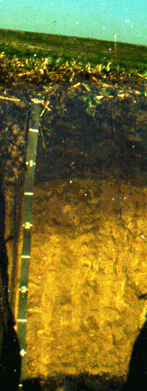
Grandbend series
The Grandbend series consists of very deep, somewhat poorly drained soils on nearly level floodplains. These soils formed in alluvium derived from mixed sources. Slope ranges from 0 to 2 percent. The mean annual precipitation is 14 to 16 inches, and the mean annual temperature is 60 to 62 degrees F.
Taxonomic class: Coarse-loamy, mixed, superactive, thermic Oxyaquic Haploxerolls
Typical Pedon
Grandbend loam, 0 to 2 percent slopes, in a field of safflower stubble. When described on November 3, 1989, the soil was moist to 16 inches and slightly moist below.

Ap—0 to 16 inches; grayish brown (10YR 5/2) loam, very dark grayish brown (10YR 3/2) moist; weak medium subangular blocky structure; slightly hard, very friable, slightly sticky and slightly plastic; common very fine roots; common very fine interstitial pores; neutral (pH 6.9); abrupt smooth boundary.
C1—16 to 27 inches; pale brown (10YR 6/3) loam, dark brown (10YR 3/3) moist; weak medium subangular blocky structure; slightly hard, very friable, slightly sticky and slightly plastic; common very fine roots; common very fine interstitial pores; slightly alkaline (pH 7.4); gradual smooth boundary.
C2—27 to 44 inches; light brownish gray (2.5Y 6/2) sandy loam, dark brown (10YR 3/3) moist; weak medium subangular blocky structure; slightly hard, very friable, slightly sticky and slightly plastic; common very fine roots; common very fine interstitial pores; few fine prominent light olive brown (2.5Y 5/6) masses of iron accumulations; slightly alkaline (pH 7.5); clear smooth boundary.
C3—44 to 54 inches; light brownish gray (2.5Y 6/2) silt loam, dark grayish brown (10YR 4/2) moist; weak medium subangular blocky structure; slightly hard, friable, slightly sticky, slightly plastic; common very fine roots; common very fine interstitial pores; common medium prominent light olive brown (2.5Y 5/4), and light yellowish brown (2.5Y 6/4) masses of iron accumulations; slightly alkaline (pH 7.4); abrupt smooth boundary.
2Ab—54 to 64 inches; dark gray (10YR 4/1) silty clay loam, black (N 2/0) moist; weak fine subangular blocky structure parting to weak medium subangular blocky; hard, firm, slightly sticky and moderately plastic; common very fine roots; few very fine tubular pores; common fine prominent pale yellow (2.5Y 7/4) masses of iron accumulations; slightly alkaline (pH 7.3); clear smooth boundary.
2Bb—64 to 67 inches; gray (5Y 5/1) silty clay loam, very dark gray (5Y 3/1) moist; weak fine subangular blocky structure parting to weak medium subangular blocky; hard, firm, slightly sticky and moderately plastic; few very fine roots; few very fine tubular pores; few fine faint light yellowish brown (2.5Y 6/4) masses of iron accumulations; neutral (pH 7.2).
Type location: Colusa County, California; located about 2 1/4 miles southwest of Grimes, California 1250 feet east and 300 feet south of the northwest corner of section 15, T. 14 N., R. 1 E., MDB&M; 39 degrees, 03 minutes, 28 seconds north latitude and 121 degrees, 51 minutes, 07 seconds west longitude; USGS Tisdale Weir, California topographic quadrangle.
Range in Characteristics
The mean annual soil temperature is 63 to 65 degrees F. The soil temperature is above 47 degrees F the entire year. The soil moisture control section, 6 and 18 inches, is dry in all parts from May 15 to October 31 and moist in some part from November 1 to May 15. The weighted average clay content of the textural control section, 10 to 40 inches, is 8 to 17 percent clay.
The Ap horizon is 10YR 5/3, 5/2; 2.5 5/2. Moist color is 10YR 3/3, 3/2; 2.5Y 3/2. Reaction is neutral.
The C horizon is 10YR 6/3; 2.5Y 6/2. Moist color is 10YR 3/3, 4/2, 5/3; 2.5Y 5/2, 3/2, 4/2, 4/4; 5Y 2.5/2. Texture is silt loam, loam, or sandy loam. Reaction is slightly alkaline.
The 2Ab horizon is 10YR 4/1, 5/1, 6/1; 2.5 6/2. Moist color is 10YR 2/1, 3/1, 4/1; N 2/0; 2.5Y 3/2. Texture is silt loam, silty clay loam or silty clay. Reaction is slightly alkaline or neutral.
The 2Bb horizon is 5Y 5/1; 2.5Y 6/2. Moist color is 5Y 3/1; 2.5Y 4/2. Texture is silty clay loam or silty clay. Reaction is neutral.